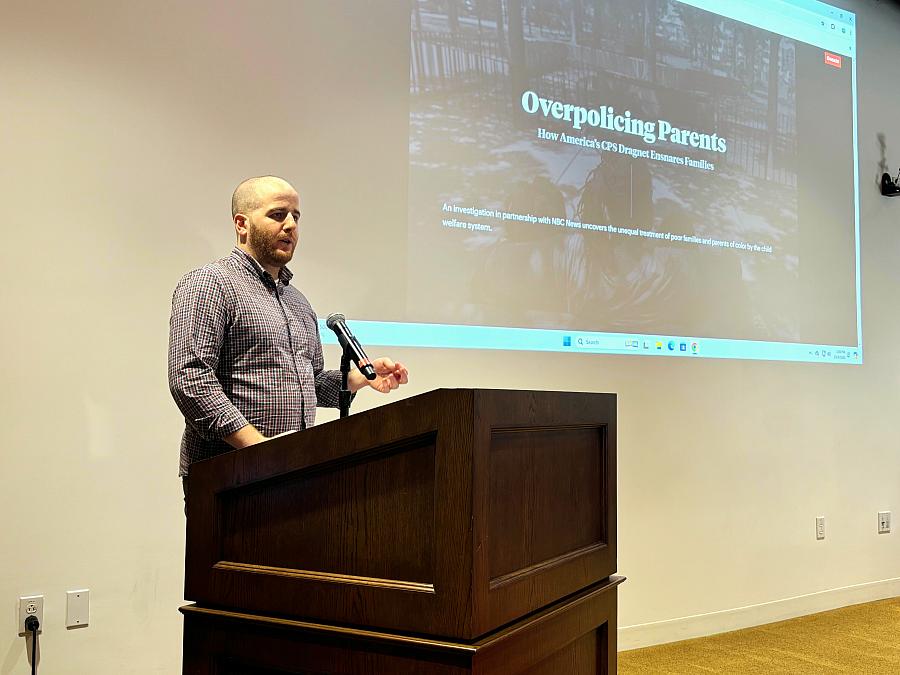ProPublica’s Eli Hager explores large national datasets to reveal troubling truths in the child welfare system

Eli Hager, a reporter for ProPublica, speaks at the 2024 Data Fellowship in Los Angeles on Oct. 8, 2024.
(Photo by ChrisAnna Mink/CHJ)
An estimated 3.5 million children a year undergo an investigation by a child welfare agency in the U.S. because of an allegation of poor treatment.
The procedures followed by social workers who perform those investigations often seem to happen in a black box — even when there’s no risk of exposing children’s identity — and that lack of transparency can hide the workings and huge scope of the system.
“I don’t feel like there is enough coverage of just how big and pervasive the child welfare system is,” said Eli Hager, a Phoenix-based reporter for ProPublica.
Hager’s reporting focuses on issues affecting youth, including child welfare, education and the criminal and juvenile justice systems. He has extensive experience using national child welfare datasets to uncover the system’s impact on children and families, which he discussed with journalists participating in the Center for Health Journalism’s 2024 Data Fellowship in Los Angeles this week.
He said most coverage of child protection services focuses on individual cases — often traumatic deaths of children — but those stories don’t reveal the behemoth size and perniciousness of child welfare systems across the country.
“With such a big system that can have such profound effects, including separation of families, I thought it was important to cover it like policing,” he said.
Hager became interested in child welfare after reporting on the criminal and juvenile justice systems for The Marshall Project. He saw a lot of overlap between the justice system and the child welfare system, since the courts play a significant role in many child welfare cases.
“Child welfare is a justice issue, a courts issue and a policing issue,” said Hager.
Hager and his ProPublica data partner, Agnel Phillip, reported a series about the overpolicing of families by child welfare agencies in a partnership with NBC News. They looked at the “front door” — when and where children entered child welfare. The goal was to make the process “less anonymous” so readers could understand the impact of child welfare on families.
“A source told me once, ‘It’s understandable that children’s names and identities should be kept anonymous, but the functioning of a system should not be anonymous,’” said Hager.
Hager and Phillip used the datasets from the National Data Archive on Child Abuse and Neglect (NDACAN), including the AFCARS and NCANDS. AFCARS is the Adoption and Foster Care Reporting System, which tracks data on youth while they’re in foster care and exiting, through adoption or reuniting with their family.
NCANDS is the National Child Abuse and Neglect Data System, which is the repository of data collected by social workers at the time youth enter the system. This data begins with the first call to the child abuse hotline, which can trigger an investigation by social workers.
Hager noted the NDACAN national database, funded by the U.S. Department of Health and Human Services and operated by Cornell University, is ladened with obscure acronyms and can be onerous to use, but it houses a treasure trove of data. For example, the databases include demographics about the children, placements, and the reasons for entry into the system, such as parental drug or alcohol abuse, neglect, inadequate housing or food, lack of supervision, as well as physical or sexual abuse.
Since all 50 states enter their cases into the database, individual state data, as well as comparisons across states, can be analyzed. Hager cautioned that humans enter the information, so there can be errors and variation.
One story from the ProPublica-NBC series used local data from Maricopa County, Arizona. Within a five-year period, one in three Black youth underwent a child welfare investigation in the county. Black parents he interviewed said that they lived in fear of an investigation and losing custody of their children.
“In Phoenix, two in three Black children will experience a CPS (child protection services) investigation by the time they turn 18,” Hager said, “In 85% of those cases, the allegation against the parents is one of neglect.”
Neglect can include drug or alcohol abuse and domestic violence in the household, among others, Hager said, but many issues are related to poverty, such as a lack of housing, food, clothing, childcare or supervision.
Another article in the series compared timelines across states for termination of parental rights. In West Virginia, parents can lose their children forever within a year of the initial investigation, and in New York, the time could be as long as two and a half years. He said both time extremes could be harmful to children living through the separations.
“Data is crucial for covering the child welfare field, because it can show the scope of how the system works,” Hager said, “I think on-the-ground reporting has to come first before doing too much with a large dataset.”
The human stories give the data meaning for readers. His general rule is “Story up to data, rather than data down to story.”
“You need to anchor your stories with individual cases to add the narrative,” Hager said, “But, the data show just how big, pervasive and omnipresent it (the child welfare system) is in the communities.”

